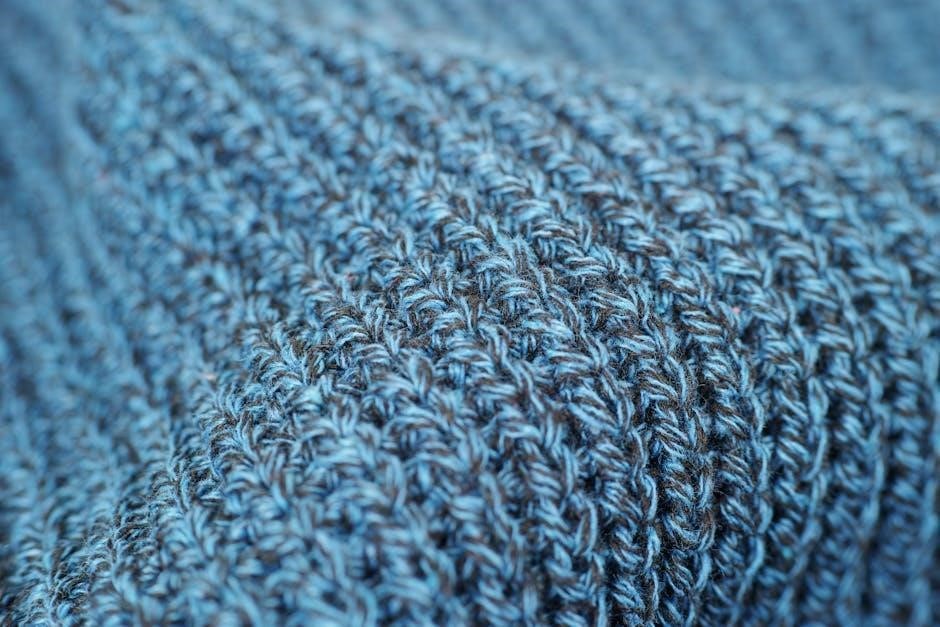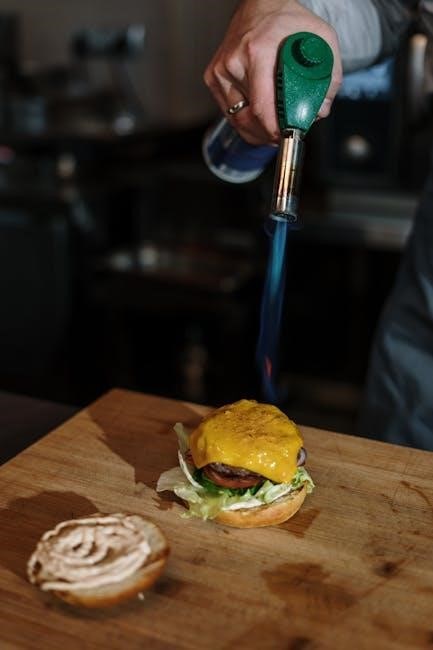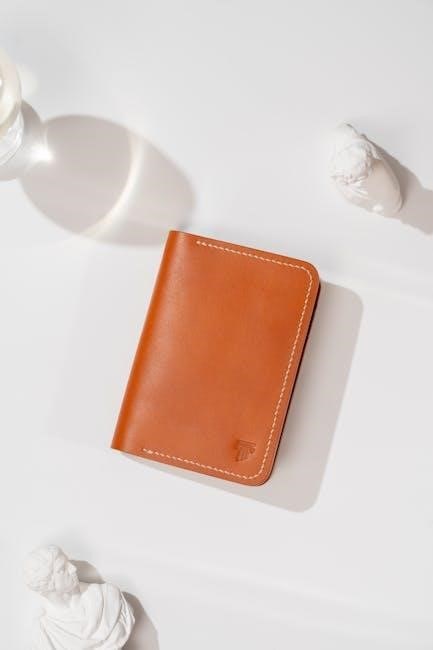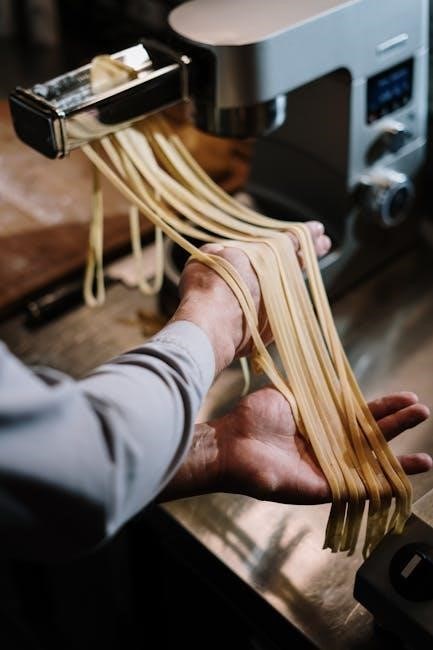kitchener stitch instructions pdf

The Kitchener Stitch is a versatile grafting technique used to invisibly join live stitches‚ creating seamless connections in knitting projects like socks‚ sweaters‚ and accessories․
What is Kitchener Stitch?
The Kitchener Stitch‚ also known as grafting‚ is a knitting technique used to join two sets of live stitches invisibly․ It creates a seamless and nearly undetectable connection‚ ideal for projects like socks‚ sweaters‚ or accessories requiring a clean finish․ This method involves a tapestry needle and yarn to weave the stitches together‚ mimicking the appearance of a knitted row․ The result is a smooth‚ professional-looking seam that blends perfectly with the surrounding fabric‚ making it nearly impossible to detect where the join occurs․ This technique is especially valued for its ability to maintain the flexibility and drape of the knitted fabric while ensuring a polished appearance․

Importance of Kitchener Stitch in Knitting
The Kitchener Stitch is a fundamental technique in knitting‚ offering a professional and invisible way to join live stitches․ Its importance lies in creating seamless connections‚ essential for projects requiring a clean finish‚ such as socks‚ sweaters‚ and accessories․ This method prevents bulky seams‚ ensuring comfort and a polished appearance‚ while maintaining the fabric’s natural drape and flexibility․ It is particularly valued for closing the toes of socks‚ where a smooth join is crucial for wearability․ The Kitchener Stitch is also useful for repairing mistakes or joining pieces without altering the knitted fabric’s integrity‚ making it an indispensable skill for knitters of all levels․
Step-by-Step Guide to Kitchener Stitch
Master the Kitchener Stitch with a detailed guide‚ ensuring seamless joins in knitting projects like socks and sweaters․ Follow clear instructions for setup‚ repeating steps‚ and finishing the seam․
Setting Up for Kitchener Stitch
To set up for the Kitchener Stitch‚ hold two knitting needles with live stitches in your left hand‚ ensuring they are parallel and the wrong sides face together․ Both needles must have the same number of stitches․ Thread a tapestry needle with the working yarn‚ leaving a 2-3 inch tail for weaving in later․ Insert the tapestry needle into the first stitch on the front needle as if to purl‚ pulling the yarn through while keeping the stitch on the needle․ This setup ensures the seam will be invisible and aligns the stitches properly for grafting․ Maintain even tension and alignment for a flawless result․

Basic Repeat Steps of Kitchener Stitch
The Kitchener Stitch involves a simple‚ repeated sequence of four steps․ Insert the tapestry needle into the first stitch of the front needle as if to knit‚ pull the yarn through‚ and remove the stitch․ Then‚ insert the needle into the first stitch of the back needle as if to purl‚ pull the yarn through‚ and remove the stitch․ Repeat these steps‚ alternating between front and back needles‚ until all stitches are grafted․ Maintain consistent tension to ensure the seam blends seamlessly with the surrounding fabric‚ creating a nearly invisible join․ This repetition is key to mastering the technique effectively․
Finishing the Seam
Once all stitches are grafted‚ secure the yarn by pulling it gently to tighten the final stitches․ Trim the excess yarn‚ leaving a small tail․ Weave the tail through the fabric using a tapestry needle to hide it․ Ensure the seam lies flat and even‚ adjusting tension if necessary․ For a polished finish‚ turn the work inside out and inspect the seam․ The Kitchener Stitch creates a nearly invisible join‚ making it ideal for projects like socks․ Properly finishing the seam ensures durability and a professional appearance‚ with no bulky or visible threads left behind․
Helpful Tips and Tricks
Use the “knit‚ purl‚ purl‚ knit” chant to remember steps․ Maintain even tension and refer to a PDF guide for visual clarity and step-by-step instructions․
Maintaining Even Tension
Maintaining even tension is crucial for a seamless Kitchener Stitch․ Too tight‚ and the fabric puckers; too loose‚ and gaps form․ Gently pull the yarn after each stitch to ensure uniformity․ Practice on scrap yarn to develop a consistent touch․ For socks‚ slight tension adjustments can prevent “ears” at the toe․ Use a tapestry needle to weave in ends neatly․ PDF guides often include tips for balancing tension‚ ensuring the stitch blends invisibly with the surrounding fabric for a professional finish․

How to Avoid Holes or Gaps
To prevent holes or gaps when using the Kitchener Stitch‚ ensure even tension and avoid pulling the yarn too tightly or loosely․ Keep the tapestry needle at a consistent angle and use a yarn tail long enough to complete the seam․ Work one stitch at a time‚ maintaining the same rhythm․ For socks‚ treat the first and last two stitches as one to eliminate “ears․” Use a PDF guide for visual cues‚ and practice on scrap yarn to master the technique․ This will help you achieve a smooth‚ invisible seam every time․

Using the Chant Method for Remembering
The Chant Method is a popular mnemonic device to remember the Kitchener Stitch sequence․ By repeating “knit‚ purl‚ purl‚ knit” aloud or in your mind‚ you can easily recall the steps․ This rhythmic approach helps maintain consistency and prevents errors․ Many knitters find it especially helpful for retaining the correct order of stitches‚ ensuring a seamless join․ PDF guides often include this tip‚ making it easier to practice and master the technique․ Over time‚ the chant becomes second nature‚ allowing you to work efficiently without constant reference to instructions․

Common Mistakes and Solutions
- Uneven tension: Adjust yarn gently while stitching․
- Miscounting stitches: Double-check stitch count before starting․
- Forgetting to leave stitches on needles: Always keep stitches on needles until instructed to remove them․
Uneven Tension Issues
Uneven tension is a common challenge when performing the Kitchener Stitch‚ leading to noticeable seams or misshapen fabric․ This often occurs when the yarn is pulled too tightly or too loosely during grafting․ To avoid this‚ gently tug the yarn after each stitch to ensure even tension‚ keeping the stitches consistent with the surrounding fabric․ If tension becomes uneven‚ stop and adjust the yarn carefully before proceeding․ Using a tapestry needle and working slowly can help maintain uniformity․ Regular practice will help develop the muscle memory needed to achieve perfectly even stitches․ This ensures a professional‚ invisible seam in your knitting projects․
Miscounting Stitches
Miscounting stitches is a frequent issue that can disrupt the Kitchener Stitch process‚ leading to mismatched seams or leftover stitches․ To prevent this‚ ensure both needles have the same number of live stitches before starting․ Count each set of stitches meticulously‚ using stitch markers if needed for accuracy․ If a miscount occurs‚ unravel the work gently and restart with the correct count․ Double-checking your counts before and during grafting helps maintain the integrity of the seam․ This attention to detail ensures a smooth‚ invisible finish‚ preserving the quality of your knitting project․ Always verify your counts to avoid unnecessary corrections later․ Consistency is key to achieving professional results with the Kitchener Stitch․
Forgetting to Leave Stitches on Needles
Forgetting to leave stitches on the needles is a common mistake that can lead to incomplete grafting or misaligned seams․ Always ensure both needles retain their live stitches throughout the Kitchener Stitch process․ If stitches are accidentally dropped or removed too soon‚ the seam may not close properly‚ resulting in gaps or unevenness․ To avoid this‚ double-check your needle setup before starting and work methodically through each step․ Keeping all stitches on the needles until instructed to remove them ensures a smooth‚ seamless finish․ Proper management of live stitches is crucial for achieving the desired invisible grafting effect in your knitting projects․
Advanced Techniques and Variations
Explore advanced Kitchener Stitch techniques‚ such as modifying for different fabrics‚ using it for socks‚ or applying variations for unique textures․ Adjust tension and experiment with custom grafting methods to elevate your knitting projects seamlessly․
Modifying the Stitch for Different Fabrics

Adapting the Kitchener Stitch for various fabrics ensures a seamless finish․ For thicker yarns‚ use a slightly looser tension to maintain flexibility․ With delicate fabrics‚ keep stitches tight to prevent gaps․ For textured knits‚ adjust the needle size or yarn weight to blend the graft with the surrounding fabric․ This customization ensures the stitch remains invisible and comfortable‚ whether used for socks‚ sweaters‚ or home decor․ Experimenting with these adjustments enhances the versatility of the Kitchener Stitch‚ making it suitable for any knitting project․
Using Kitchener Stitch for Socks
The Kitchener Stitch is most famously used to close the toes of socks‚ creating an invisible‚ comfortable seam․ To avoid “ears” at the toe‚ treat the first and last two stitches on both needles as one‚ blending them seamlessly․ Ensure both needles hold the same number of stitches and keep wrong sides together for symmetry․ Gently pull yarn to match the fabric’s tension‚ preventing tightness or looseness․ This technique ensures a professional finish‚ making it ideal for sock-making․ With practice‚ the Kitchener Stitch becomes an essential tool for crafting flawless‚ wearable socks․
Alternative Methods for Grafting
Beyond the Kitchener Stitch‚ knitters can explore alternative grafting methods․ One popular technique involves using a simple “purl when you can‚ knit when you must” mantra․ Another method incorporates safety pins to hold stitches in place‚ simplifying the process․ For purl-dominated fabrics‚ reversing the stitch order ensures a seamless blend․ Additionally‚ a bind-off variation allows grafting directly from the needles without a tapestry needle․ These alternatives offer flexibility‚ catering to different project needs and stitch patterns‚ while still achieving an invisible seam․ Experimenting with these methods can enhance your grafting skills and expand your knitting repertoire․

Downloading Kitchener Stitch Instructions as PDF
Downloadable PDF guides provide clear‚ step-by-step instructions for mastering the Kitchener Stitch․ These resources are ideal for beginners and experienced knitters alike‚ offering convenience and clarity․

Where to Find Reliable PDF Guides
Reliable PDF guides for the Kitchener Stitch can be found on trusted knitting websites like Knitting News and Tin Can Knits․ These platforms offer free‚ downloadable resources with clear step-by-step instructions and visuals․ Many patterns‚ such as the Flax pattern‚ include Kitchener Stitch tutorials in their PDF formats․ Additionally‚ websites like Knitty and knitting blogs provide accessible guides․ These resources are perfect for knitters of all skill levels‚ ensuring a seamless learning experience․ Downloading a PDF guide allows you to practice anytime‚ making it an excellent tool for mastering the technique․

Benefits of Using a Printable Guide
A printable Kitchener Stitch guide offers convenience and clarity‚ providing a tangible resource for learning․ It allows you to practice without internet access‚ making it ideal for on-the-go projects․ The step-by-step instructions and visuals ensure easy comprehension‚ even for beginners․ Printable guides also enable you to mark progress and revisit complex steps as needed․ Many PDFs are designed for all skill levels‚ offering a comprehensive yet approachable learning experience․ This accessibility makes mastering the Kitchener Stitch more achievable and enjoyable for knitters of all backgrounds․
Mastering the Kitchener Stitch enhances your knitting skills‚ enabling professional‚ seamless results; Its versatility makes it indispensable for projects like socks and sweaters‚ ensuring a polished finish every time․
Final Thoughts on Mastering Kitchener Stitch
Mastering the Kitchener Stitch is a milestone in knitting‚ offering a professional finish to projects․ It ensures invisible seams‚ essential for garments like socks‚ where comfort and aesthetics matter․ With practice‚ knitters can achieve uniform tension and avoid common pitfalls․ The stitch’s versatility extends beyond socks to sweaters and accessories‚ making it a valuable skill․ By following step-by-step guides and tips‚ knitters can confidently incorporate this technique into their work‚ elevating their projects to new heights of quality and craftsmanship․
Encouragement to Practice and Explore
Practice is key to mastering the Kitchener Stitch‚ as it builds confidence and familiarity with the technique․ Start with small projects like sock toes to gain comfort‚ then explore its use in sweaters or accessories․ Don’t be afraid to experiment with variations or advanced methods once you’ve mastered the basics․ Consistent practice will help you achieve seamless‚ professional-looking results․ Embrace the process‚ and soon you’ll be creating beautiful‚ invisible seams with ease․ Happy knitting and enjoy the satisfaction of crafting flawless‚ professional-quality garments!



Leave a Reply
You must be logged in to post a comment.